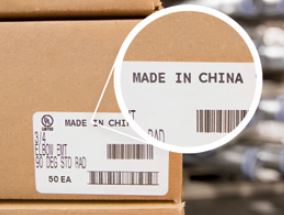Contractors, Buy with Caution!
Don’t see a country of origin on your product for projects that require domestically made products? Don’t assume it’s American-made! Installing foreign product on a job that requires domestic materials can be costly.
U.S. Customer and Border Protection requires markings indicating country of origin on steel and iron pipe and fittings coming into the United States. But foreign EC&N manufacturers don’t always follow this rule! It’s easy to confuse unmarked imports with American-made products at a glance. Be sure you know the difference, so you don’t accidentally install imports on projects with “Made in USA” requirements. This could require products to be removed and replaced, resulting in significant costs and delays.
3 Tips for Verifying Country of Origin:
- Check the box label for country of origin on imported material.

- Verify country of origin is listed on each piece within the box. If not, contact your vendor for replacement product with proper markings.

- Buy from Wheatland when you need American-made EC&N.

Buy American. Eliminate the risks by choosing Wheatland Tube’s American-made products for your projects.
Import Markings FAQs
What is the purpose of marking?
To inform the ultimate purchaser in the United States of the country in which the imported article was made.
Who is the ultimate purchaser?
The ultimate purchaser is generally the last person in the United States who will receive the article in the form in which it was imported. If the article will be used in manufacturing, the manufacturer or processor in the United States is the ultimate purchaser if the professing of the imported article results in a substantial transformation of the imported article, becomes a good of the United States under the NAFTA marking Rules (19 CFR Part 102), or becomes a good of the United States under the Textile rules of origin (19 CFR 102.21), as applicable.
What is the country of origin?
The country of manufacture, production, or growth of the article.
Should the marking be of a particular size?
The marking must be legible. This means it must be of an adequate size, and clear enough, to be read easily by a person of normal vision.
Where should the marking be located?
The marking should be located in a conspicuous place. It need not be in the most conspicuous place, but it must be where it can be seen with a casual handling of the article. Markings must be in a position where they will not be covered or concealed by subsequent attachments or additions. The marking must be visible without disassembling the item or removing or changing the position of any parts.
What are the acceptable forms of marking?
The best form of marking is one which becomes a part of the article itself, such as branding, stenciling, stamping, printing, molding, and similar methods. Other forms of marking will also be acceptable if it is certain that the marking will remain legible and conspicuous until the article reaches the ultimate purchaser in the United States. It is important that this marking withstand handling. This means it must be of a type that can be defaced, destroyed, removed, altered, obliterated, or obscured only by a deliberate act.
What are the special marking requirements for other articles?
Pipes and pipe fittings of iron, steel or stainless steel must be marked by means of die stamping, cast-in-mold lettering, etching, engraving, or continuous paint stenciling. If it is commercially or technically infeasible to mark by one of these five methods, the marking may be done by an equally permanent method of marking, or, in the case of small-diameter* pipe, tube and fittings, by tagging the bundles.
Do marking duties apply?
Articles that are not marked with the English name of their country of origin at the time of their importation into the United States shall be subject to additional duties unless properly marked, exported, or destroyed under CBP supervision prior to liquidation of the entry.
What are the criminal penalties for removal of markings?
Any person who removes, destroys, alters, covers, or obliterates with the intent of concealing the country of origin marking on an imported article could be subject to prosecution and criminal penalties.
Eliminate the risks by choosing American-made products for your projects. Use our rep locator or call 800.257.8182 to find a local distributor in your area.
*14″ or less in diameter The questions and responses above were copied from the U.S. Customs and Border Protection website (cbp.gov) for your reference when inspecting imported products.
